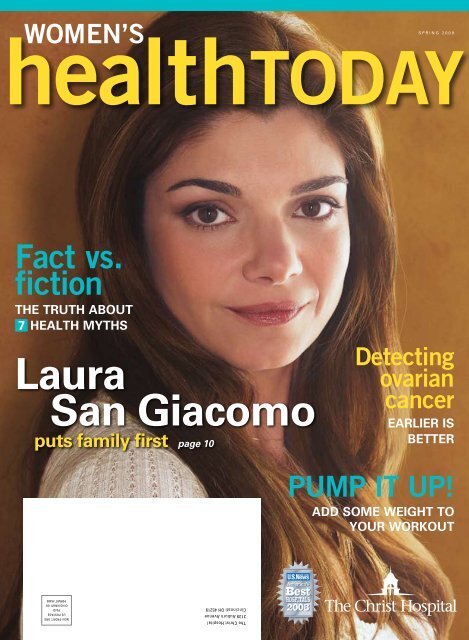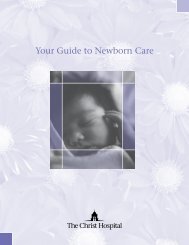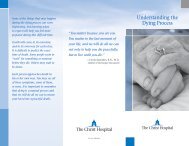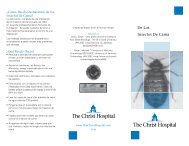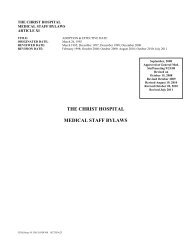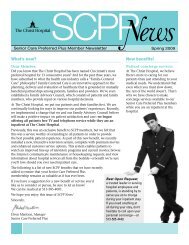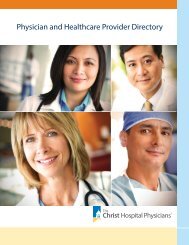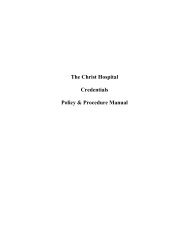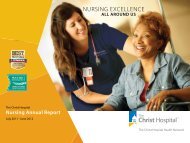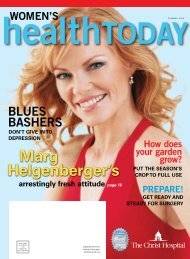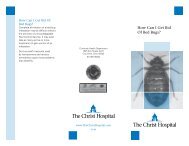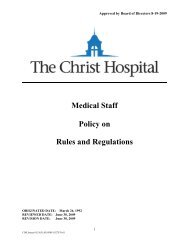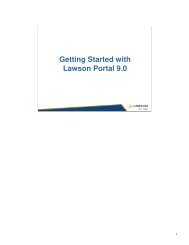Laura San Giacomo - The Christ Hospital
Laura San Giacomo - The Christ Hospital
Laura San Giacomo - The Christ Hospital
- No tags were found...
You also want an ePaper? Increase the reach of your titles
YUMPU automatically turns print PDFs into web optimized ePapers that Google loves.
in this issue . . .2 L E T T E R F R O M T H E F O U N D E R<strong>The</strong> joys and pains of being a woman3 Screening saves livesGet tested for carotid artery disease4 Stand straight!You’ll look and feel better for it6 H E A L T H H E A D L I N E SWhat’s making news inwomen’s health48 Feeling the (heart)burn?Antacids aren’t always the answer9 S E X & G E N D E R M A T T E R SCoping with economic crisis10 C O V E R S T O R YBusy beyond beliefBut <strong>Laura</strong> <strong>San</strong> <strong>Giacomo</strong> loves every minuteof her hectic lifestyle!14 H E A L T H Y B I T E STasty tidbitsNo-guilt nibbles816 Ovarian cancer cluesDon’t ignore these symptoms18 7 medical misconceptionsWhat you don’t know can hurt you1420 Something under your skin?<strong>The</strong> truth behind bothersome lumpsand bumps21 Don’t stress over this test22 H E A L T H Y M O V E SLift that weight!Do your body some good24 H E A L T H S M A R T SPuzzling periods21
Letter from the founderwomen’shealthtodayt h e m a g a z i n e o ft h e f o u n d a t i o n f o r f e m a l e h e a l t h a w a r e n e s s<strong>The</strong> joys and pains ofbeing a womanYou don’t need me, as an Ob/Gyn, to tell you about all the joys ofwomanhood. But being a woman sometimes brings health risksnot faced by men. Ovarian cancer is one threat that many womenfear. While an estimated 15,500 women died from the disease in 2008,the five-year survival rate for women who are diagnosed in the earlieststages—when the cancer is still localized—is almost 93 percent. Nowthat’s a statistic worth repeating. <strong>The</strong> early detection of ovarian cancer isthe major contributor to this heartening figure. Read about one patient’sstory and learn the early warning signs in “Ovarian cancer clues” on page 16.Eating right is another proven way to stay healthy. If you’re asnacker, see “Tasty tidbits” on page 14 to find nine guilt-free, satisfyingfoods. Also in this issue of Women’s Health Today, you’ll find articles onantacids (“Feeling the [heart]burn?”, page 8), skin issues (“Somethingunder your skin?”, page 20) and body building (“Lift that weight!”, page22) along with more timely and easy-to-understand health information.We aim to cover a wide variety of health-related topics in Women’sHealth Today; let me know what topics you’d like to read about in futureissues. I’d love to hear from you!Sincerely,F o u n d e r sMickey M. Karram, MD / Mona KarramN a t i o n a l A d v i s o r y B o a r dLinda Brubaker, MD, Professor of Obstetrics and Gynecology,Urogynecology Urology, Loyola University Chicago Stritch Schoolof Medicine; Co-Director, Women’s Pelvic Medicine Center,Loyola University Medical CenterVivien K. Burt, MD, PhD, Associate Professor of Clinical Psychiatry,<strong>The</strong> David Geffen School of Medicine at UCLA; Founder and Director,Women’s Life Center, UCLA Neuropsychiatric Institute and <strong>Hospital</strong>Vivian M. Dickerson, MD, Associate Clinical Professor ofObstetrics and Gynecology, University of California Irvine; Director,Division of General Obstetrics and Gynecology, UCI Medical Center;Director of UCI’s Post Reproductive Women’s Integrative Health CenterTommaso Falcone, MD, Professor and Chairman, Departmentof Gynecology and Obstetrics, <strong>The</strong> Cleveland Clinic Foundation;Co-Director, Center for Advanced Research in Human Reproductionand InfertilitySebastian Faro, MD, PhD, Clinical Professor of Obstetrics andGynecology, Women’s <strong>Hospital</strong> of TexasNieca Goldberg, MD, Assistant Professor of Medicine,SUNY Health Science Center, Brooklyn, New York;Clinical Assistant Professor of Medicine, New York UniversityThomas Herzog, MD, Professor of Clinical Obstetrics andGynecology, Columbia University College of Physicians and Surgeons;Director, Division of Gynecologic Oncology, Columbia UniversityMedical Center, New YorkBarbara Levy, MD, Medical Director, Women’s Health & BreastCenter, St. Francis <strong>Hospital</strong>, Federal Way, Washington; AssistantClinical Professor of Obstetrics & Gynecology, Yale University Schoolof Medicine; Assistant Clinical Professor of Obstetrics and Gynecology,University of Washington School of MedicineWendy l. wright, ARNP, FAANP, Adult/Family NursePractitioner; Adjunct Faculty, Fay W. Whitney School of Nursing,University of WyomingT h e C h r i s t H o s p i t a l S T A F FPresident and CEO Susan CroushoreVice President, Operations Victor DiPillaCNO/Vice President, Nursing Deborah HayesVice President, Marketing and Community Relations Heather AdkinsVice President and Chief Medical Officer Berc Gawne, MDEditor Arin Kraemerc u s t o m e r s e r v i c eFor more information about services at <strong>The</strong> <strong>Christ</strong> <strong>Hospital</strong>,please contact Arin Kraemer at arin.kraemer@thechristhospital.com or(513) 585-3945.Women’s Health Today is published four times a year by<strong>The</strong> <strong>Christ</strong> <strong>Hospital</strong>, 2139 Auburn Avenue, Cincinnati, OH 45219,in conjunction with the Foundation for Female Health Awareness,PO Box 43028, Cincinnati, OH 45243. This is Volume 5, Issue 2.© 2009 by <strong>The</strong> <strong>Christ</strong> <strong>Hospital</strong> and the Foundation forFemale Health Awareness. All rights reserved.Mickey M. Karram, MDPRESIDENT AND Co-FounderFoundation for Female Health AwarenessDr. Karram and his wife, Mona, are the founders of the Foundation for Female HealthAwareness, a nonprofit organization dedicated to improving women’s health by supportingunbiased medical research and educating women about their health.<strong>The</strong> information contained herein is not a substitute for professionalmedical care or advice. If you have medical concerns, seek theguidance of a healthcare professional.Women’s Health Today magazine is part ofWomen’s Health Experience, the flagship program of theFoundation for Female Health Awareness. Women’s HealthExperience is a unique initiative aimed at connecting women withhealthcare experts, as well as their local hospitals, to learn aboutimportant issues that may affect their health. Through Women’sHealth Experience regional conferences, Women’s Health Todaymagazine and www.womenshealthexperience.com, you’ll get objective,timely information. You can also sign up for free e-newsletterscontaining health news and results of medical studies.Sign up now at www.womenshealthexperience.com.c o v e r : L AU R A S A N G I AC O M O © 2 0 0 9 F r a n k O c k e n f e l sWomen’s Health TodayPlease Recycle This Publication
Screeningsaves livesGet testedfor carotidarterydiseaseRisk factorsCarotid artery disease screening uses painlessultrasound technology to create images using soundwaves. If you’re at risk, discuss screening with yourphysician. Risk factors include smoking, high bloodpressure, diabetes and high cholesterol.“Anything greater than a 70 percent blockagetypically requires surgery,” says Dr. Bulas. If strokesymptoms are present—blindness, weakness, numbnessor speech difficulties—surgery or stenting maybe needed even if the 70 percent threshold isn’t met.Your age and health also help determine treatment.Trudy Williams never dreamed she hadcarotid artery disease, but a simple vascularscreening showed that her right carotidartery was more than 90 percent blocked.“Carotid artery disease occurs when plaquelines the arteries on either side of the neck—thecarotid arteries,” says Robert Bulas, MD, medicaldirector of vascular neurointervention at <strong>The</strong> <strong>Christ</strong><strong>Hospital</strong> in Cincinnati. A potentially life-threateningstroke is often the disease’s only symptom: Plaque ora blood clot breaks off, blocks smaller blood vesselsand cuts off blood supply to the brain.Williams’ disease was discovered through a vascularscreening of her neck, abdomen and legs before astroke could occur. Additional tests showed blockagesin her chest. Williams underwent quadruple bypasssurgery last fall, followed by carotid artery surgery.She says of the results, “I feel 100-percent betternow.” While she’d been considering retirement beforeher surgeries because of her extreme fatigue, Williamshappily returned to work in January.A multidisciplinary approachIf you need treatment, choose a multidisciplinarycenter like <strong>The</strong> <strong>Christ</strong> <strong>Hospital</strong>, where physiciansoffer several treatment modes, including:• Carotid endarterectomy. Typically for youngerpatients like Williams, endarterectomy involves anopen-neck incision under general anesthesia. A surgeonshaves plaque from artery walls to restore blood flow.• Carotid stenting. A thin tube is placed through asmall opening in the carotid artery to restore bloodflow. Stenting may be preferred if a blockageis hard to reach, endarterectomy was performedpreviously or general anesthesiawould create excessive patient risk.“<strong>The</strong> best way to prevent carotidartery disease and its consequences isto see your primary care physicianregularly to identify and treat highrisk factors such as high bloodpressure,” saysDr. Bulas. WHTDon’t delay this screening!To schedule a vascular screening at <strong>The</strong> <strong>Christ</strong> <strong>Hospital</strong>, call 513-936-5291. <strong>The</strong> <strong>Christ</strong><strong>Hospital</strong> offers a low-cost arterial ultrasound to check arteries in the neck, abdomen andlegs. To find a physician, call <strong>The</strong> <strong>Christ</strong> <strong>Hospital</strong> physician referral line at 513-585-1000.Robert Bulas, MD, is medical director of vascular neurointervention at <strong>The</strong> <strong>Christ</strong> <strong>Hospital</strong> in Cincinnati.www.womenshealthexperience.com
Standstraight!You’ll look and feel better for itAs a child, you were probably told to standup straight. That’s still great advice:Standing erect and sitting properly canhelp reduce stress on joints, ward offmuscle pain and improve balance to prevent falls.You’ll feel the price of poor posture. Painful,achy joints steal your sleep and lead to irritabilityand fatigue. Hunching or tilting to one side makesyou vulnerable to falls. Unbalanced pressure onspinal disks can cause neck, back and shoulder pain.Improper alignment can contribute to musculoskeletaldiseases such as osteoarthritis, rheumatoidarthritis, osteoporosis, herniated disks and degenerativedisk disease.<strong>The</strong> aging bodyPhysical changes that occur with age and lifestylehabits can lead to slouching. With passingbirthdays, people typically experience the following:• Muscles shrink and lose mass. Strength diminishesand reflexes slow.• Bone loss outpaces bone building. Bones lose densityand strength and break more easily.• Ligaments, which connect bones at joints, lose elasticity.Overall flexibility diminishes.• Activity decreases. People tend to move less andin more repetitive ways. Some muscles stay strongwhile others weaken.<strong>The</strong> result? Your body loses correct alignment, puttingyou at risk for musculoskeletal disorders and pain.Checking your position<strong>The</strong> way you hold your body—standing andsitting—is key to proper posture. Michael T.Rohmiller, MD, orthopedic surgeon at <strong>The</strong> <strong>Christ</strong><strong>Hospital</strong> in Cincinnati, suggests addressing youralignment with these assessments and guidelines:• Stand tall. Stand in front of a mirror. BreatheBeware boomeritisToday’s older adults are far moreactive than previous generations—and they have the aches and painsto prove it. In fact, sports injurieslike tendinitis and bursitis havebecome so common among theover-50 set, there’s a name for thecondition—boomeritis.Some injuries result fromyears of overuse or repetitivemovements. Others happen whenout-of-shape weekend warriors tryto get back in the game like theydid when they were younger. Youcan stay active and pain free andavoid getting sidelined by boomeritisby following these tips fromDr. Rohmiller:• Gear your workouts to your ownfitness level and goals.• Know your weak link, such as apreviously injured joint, and avoidactivities that may strain it.• Mix up your exercise routinefor balanced fitness. Includecardiovascular activities (walking orjogging), strength training(lifting weights) andflexibility exercises(stretching or yoga).• Choose low-impact aerobicactivities like biking, swimming ordancing.• Warm up before exercising.• Check with your physician to besure you’re getting enough calciumand vitamin D to maintain bonestrength. Add dietary supplementsif necessary.Women’s Health Today
deeply and relax. Is your head straight and are yourshoulders and hips level? Do you see equal spacesbetween your arms and sides? Do your kneecapsface forward and are your ankles straight?• Sit smart. Position yourself correctly whenseated, especially if you use a computer. Usea pillow to support your lower back. Adjustyour chair so your feet are flat on thefloor and your knees are at a 90-degreeangle. <strong>The</strong> top of your screen should belevel with the top of your head.Improve your postureMaintaining good posture through the yearscalls for conscious effort. Exercising regularly tokeep your muscles strong and flexible and to maintaingood balance is key to holding and carryingyour body correctly. Dr. Rohmiller suggests theseexercises to help you improve and maintain correctbody alignment:• Strengthen core muscles. <strong>The</strong> strength of yourcore, especially your abdominals, is key to backstability. To strengthen them, lie on your back withyour arms at your sides. Using your abdominalmuscles to lift your head, neck and shoulder bladesoff the floor, slowly curl up. Repeat 15 times.• Boost your balance. Wear sturdy shoes to practicethis exercise: Grasp a countertop or the back of achair. Stand on one leg for one minute; switch legs.As you improve, increase the time, close your eyes ordon’t use an object for support.Many people with chronic pain, particularlyback pain, can trace their problem to faulty posture.Self-care efforts to improve alignment may not beenough to undo years of slouchingand bad habits like carrying an overloadedshoulder bag, but you can Don’t back down from pain!keep poor posture from getting progressivelyworse by taking the stepsaccompanied by numbness and tingling or occurs after a fall or anIf you have back pain that’s severe, doesn’t improve with rest, ismentioned here and visiting yourinjury, call <strong>The</strong> <strong>Christ</strong> <strong>Hospital</strong> Spine Institute at 513-585-BACK.physician. WHTMichael T. Rohmiller, MD, is an orthopedic surgeon with <strong>The</strong> <strong>Christ</strong> <strong>Hospital</strong> Spine Institute in Cincinnati.www.womenshealthexperience.com
what’smaking newsin women’shealthhealthheadNuts: <strong>The</strong> secret toa healthy heart?<strong>The</strong>re’s been buzz for years now aroundthe heart-healthy Mediterranean diet.Olive oil is usually thought to be the secretingredient that makes the diet so healthy,but it turns out that nuts may be the key.Researchers in Spain studied more than1,200 people ages 55 to 80 at high risk forcardiovascular disease. About two-thirds ofthe participants also met criteria for metabolicsyndrome: <strong>The</strong>y had abdominal obesity,high cholesterol, high blood pressure andhigh glucose levels. <strong>The</strong> researchers dividedthe participants into three groups. <strong>The</strong>y gavethe control group advice on a low-fat diet andthe other two groups received informationabout the Mediterranean diet, which includesplenty of cereal, vegetables, fruits and oliveoil; a modest intake of fish and alcohol; andIt’s tough, but youcan quit smokingKicking the smoking habit can be especially toughfor women. Dealing with the intense withdrawalsymptoms such as depression, irritability, anxiety,lack of energy, concentration problems and weightchanges can be challenging. But you can quit—evenif it takes several attempts. Try these four tips to helpyou succeed:• Set a quit date or vow to quit within a certain timeframe, like 30 days.• Use quit-smoking aids such as nicotine patchesand gum, inhalers, nasal sprays or medication todouble your chances of success.• Seek help from an expert, such as a tobaccotreatment specialist. He or she can create a treatmentplan, which mayinclude counseling orother aids, tailored toyour needs.• Build a network.Friends, family, coworkersand online supportgroups can be anenormous help duringthis difficult time.a small amount of dairy, meats and sweets. One of the Mediterranean diet groupswas also given one liter a week of virgin olive oil; the other got 30 grams a day ofwalnuts, hazelnuts and almonds. After a year, the prevalence of metabolic syndromedropped by 14 percent in the mixed-nut group, 7 percent in the olive oil group and2 percent in the control group. No one lost weight, but the number of people in theMediterranean-diet groups who had a large waist circumference, high triglycerides (atype of blood fat) and high blood pressure dropped compared to the control group.© 2009 JupiterimagesWomen’s Health Today
sex & Gender matters<strong>The</strong> latest findings on women-specific healthfrom the Society for Women’s Health ResearchBy Jennifer Wider, MDCoping witheconomic crisis© 2009 Jupiterimages<strong>The</strong> economic crisis is all over magazines,newspapers and the news. It’s no wonderpeople are feeling anxious and stressed out.But women may be reactingmore strongly than men. A surveyfrom the American PsychologicalAssociation (APA) says women areexpressing fear about the currentfinancial situation more than men.Women are reporting physicaland psychological symptoms,including sleep disturbances, headaches,mood swings and changes inappetite, in higher numbers than men.“Women have many roles to play inlife. <strong>The</strong>y’re often the primary caregivers forchildren and the older generations [aging parents], aswell as workers in industry,” says Stephanie Smith, PsyD,public education coordinator for the APA.In addition to the caretaking role, many traditionalhousehold responsibilities—like cooking,cleaning and laundry—end up falling on women’sshoulders. All of this responsibility can add up toa lot of stress, especially when families are beingsqueezed financially. (That’s not to say men aren’tstressed out, too. Seventy-five percent of malerespondents expressed fear about the economy,compared to 84 percent of women.)Tools for trying timesSince everyone reacts differently to stress, a keyto maintaining good health during these times is toknow your own warning signs—the physical symptomsthat indicate when your brain and body areexperiencing unusual or excessive pressure, such asheadaches, exhaustion and depression.You can take measures to safeguardyour health during these difficult times.Take time out each day to focus onyourself and your own well-being.Learn more!Continue going to your aerobicsclass, eating dinner with your familyand participating in social activities.Don’t cut back on preventiveand basic healthcare services. Savingmoney on health expenditures may seemlike a good idea in the short run, but it canlead to serious health problems and enormousbills, making financial matters worse.To stretch your healthcare dollars, talk to yourprimary care physician about all your health needsand concerns. If he or she can manage multiple conditions,it can cut down on the number of physiciansyou visit and related out-of-pocket expenses.For tips on recognizing and coping with stress,visit www.apahelpcenter.org. WHT<strong>The</strong> Society for Women’s Health Research isa nonprofit research, education and advocacyorganization that works to improve women’shealth through sex-specific research, educationand advocacy. For more of the latest news andresearch on women’s health, visit their Web siteat www.womenshealthresearch.org.Jennifer Wider, MD, is a medical advisor for the Society for Women’s Health Research in Washington, D.C.www.womenshealthexperience.com
continued from page 11Family firstMason, who has cerebral palsy, is an integralpart of <strong>San</strong> <strong>Giacomo</strong>’s everyday life. She’s becomea children’s advocate, championing his educationand helping found an award-winning charter school inthe <strong>San</strong> Fernando Valley. <strong>The</strong> school is a proponentof inclusion education, a method where children of allabilities learn together. “Mason loves school, so I followedhis lead and that’s what I tried to champion forhim,” says <strong>San</strong> <strong>Giacomo</strong>. “I’ve seen through his educationthat everyone learning together is a very valuableexperience. We can talk about diversity all we want, butwhen we’re living it, it’s really no big whoop.”It takes a lot of stamina to keep <strong>San</strong> <strong>Giacomo</strong>’shectic schedule of filming, raising Mason and keepingher marriage strong, but the New Jersey nativehas some surefire methods for keeping a low-stresspace. “I laugh in the face of people who say anythingabout being calm,” she loudly giggles. “We laughall the time in our house and sometimes it’s a challenge.”One of her tougher trials came when Masonneeded hip surgery and muscle repair last December.“I kept saying everything’s going to be fine. And wedid laugh, which helped us all get through it,” says<strong>San</strong> <strong>Giacomo</strong>.Mason’s move from preschool to kindergartenwas a pivotal hardship on <strong>San</strong> <strong>Giacomo</strong>. “That’show I learned to mentally front-load—to ask myself,‘What’s going to help me get through this nexttransition?’ ” she says. Now she avoids overbookingduring busy back-to-school time. “That way, nothingsneaks up and bites me in the butt. I think aboutlife and motherhood and how we want to control allof it. But one of the lessons of motherhood is thatyou’re not in control. You have to learn to let go ofthe side of your ego that thinks you can make everythingright, and just go with the flow of that particularmoment,” says <strong>San</strong> <strong>Giacomo</strong>.of time every evening checking in. We’re availableto each other to see how things are going, to discussdecisions. <strong>The</strong> porch is one way we make sure to havesome alone time.”<strong>San</strong> <strong>Giacomo</strong> also loves to zone out in her garden.“I have a little Buddha sculpture, some paintings thatmy son has done over the years, some rocks, little turtles,a blue frog and a silver bird sitting on a rock.” Tocomplete the serenity, a blue fairy tile that her mothergave her rests nearby. “Just sitting there and doingnothing is really good for me,” she says.Giving gratitudeBorn into a large Italian family, one of <strong>San</strong><strong>Giacomo</strong>’s most vivid childhood memories revolvesaround “the sound of my mom’s wooden spoon hittingthe side of the saucepan—she’d be making sauce,or as we called it, the gravy. It’s a real comfortingsound to me now when I’m making my gravy,” shesays. “And my son’s really aware of my cooking whenhe comes home from school. He loves the aroma ofgarlic, olive oil and onion sautéing.” Her sensory signalstake her back to when life wasn’t so hectic. “I’mat a point in my life where I can really see that thingshave changed,” says <strong>San</strong> <strong>Giacomo</strong>. “But I’ve foundthere’s great power in life-affirming gratitude. I try toteach my son by example that we live in a crazy, modernworld, but with a little bit of gratitude, we canobtain a balance.”While Mason is the primary focus of <strong>San</strong><strong>Giacomo</strong>’s everyday life, the actress still finds thetime to maintain her personal health and stamina. Sheenjoys a game of tennis or golf and occasionally iceskating.But she’s still an active participant in Mason’seducation. “At his schools, I’ve seen this great valuingof all people and self worth,” says <strong>San</strong> <strong>Giacomo</strong>.Discovering value and self worth in herself—andothers—has paid off handsomely. “I have a sense ofHelpful hometime<strong>The</strong> house <strong>San</strong> <strong>Giacomo</strong> shares with her familyis very much a home, complete with a large backporch, glorious vegetable garden and flowerbeds anda large, airy kitchen. Anxiety reducers hereinclude “me-time” gardening, or just sittingon the back porch spending quality timewith her husband. “Date nights? Who hasthe time?” she asks. “Matt and I spend a lot<strong>San</strong> <strong>Giacomo</strong>and “AmazingGrace” co-starHolly Hunter.purpose and a sense of belonging,” she says. WHT12Women’s Health Today
Want fewer urges and leaks in your internal plumbing?VESIcare can make a difference.When your bladder muscle is overactive, it can cause those frustrating urges, so youworry your pipes might leak. This can sometimes get in the way of what you love to do.So it’s harder to always do things spur of the moment. VESIcare, once a day, helps controlyour bladder muscle, so it can reduce urges and leaks, day and night. If you’vehad enough, talk to your doctor again about taking care with VESIcare.Important Safety InformationVESIcare is for urgency, frequency, and leakage (overactive bladder). VESIcare isnot for everyone. If you have certain stomach or glaucoma problems, or troubleemptying your bladder, do not take VESIcare. Tell your doctor right away if youhave a serious allergic reaction, severe abdominal pain, or become constipatedfor three or more days. VESIcare may cause blurred vision, so take care whiledriving or doing unsafe tasks until you know how VESIcare affects you.Common side effects are dry mouth, constipation, and indigestion.Call (800) 403-6565 or visitvesicare.com and you’ll receive:Information about overactive bladder$25 savings check*Talk to your doctor guideTake care withPlease see important product information on the following page.*Subject to eligibility. Restrictions may apply.You are encouraged to report negative side effects of prescription drugs to the FDA.Visit www.fda.gov/medwatch, or call 1-800-FDA-1088.
T:2.125 inPatient InformationVESIcare ® – (VES-ih-care)(solifenacin succinate)Read the Patient Information that comes with VESIcare before you starttaking it and each time you get a refill. <strong>The</strong>re may be new information.This leaflet does not take the place of talking with your doctor or otherhealthcare professional about your condition or treatment. Only yourdoctor or healthcare professional can determine if treatment withVESIcare is right for you.What is VESIcare ® ?VESIcare is a prescription medicine used in adults to treat the followingsymptoms due to a condition called overactive bladder:• Having to go to the bathroom too often, also called “urinary frequency,”• Having a strong need to go to the bathroom right away, also called“urgency,”• Leaking or wetting accidents, also called “urinary incontinence.”VESIcare has not been studied in children.What is overactive bladder?Overactive bladder occurs when you cannot control your bladdercontractions. When these muscle contractions happen too often or cannotbe controlled, you can get symptoms of overactive bladder, which areurinary frequency, urinary urgency, and urinary incontinence (leakage).Who should NOT take VESIcare ® ?Do not take VESIcare if you:• are not able to empty your bladder (also called “urinary retention”),• have delayed or slow emptying of your stomach (also called “gastricretention”),• have an eye problem called “uncontrolled narrow-angle glaucoma”,• are allergic to VESIcare or any of its ingredients. See the end of thisleaflet for a complete list of ingredients.What should I tell my doctor before starting VESIcare ® ?Before starting VESIcare tell your doctor or healthcare professionalabout all of your medical conditions including if you:• have any stomach or intestinal problems or problems with constipation,• have trouble emptying your bladder or you have a weak urine stream,• have an eye problem called narrow-angle glaucoma,• have liver problems,• have kidney problems,• are pregnant or trying to become pregnant (It is not known ifVESIcare can harm your unborn baby.),• are breastfeeding (It is not known if VESIcare passes into breast milkand if it can harm your baby. You should decide whether to breastfeedor take VESIcare, but not both.).Before starting on VESIcare, tell your doctor about all the medicinesyou take including prescription and nonprescription medicines,vitamins, and herbal supplements. While taking VESIcare, tell yourdoctor or healthcare professional about all changes in the medicinesyou are taking including prescription and nonprescription medicines,vitamins and herbal supplements. VESIcare and other medicines mayaffect each other.How should I take VESIcare ® ?Take VESIcare exactly as prescribed. Your doctor will prescribe thedose that is right for you. Your doctor may prescribe the lowest dose ifyou have certain medical conditions such as liver or kidney problems.• You should take one VESIcare tablet once a day.• You should take VESIcare with liquid and swallow the tablet whole.• You can take VESIcare with or without food.• If you miss a dose of VESIcare, begin taking VESIcare again thenext day. Do not take 2 doses of VESIcare in the same day.• If you take too much VESIcare or overdose, call your local PoisonControl Center or emergency room right away.What are the possible side effects with VESIcare ® ?<strong>The</strong> most common side effects with VESIcare are:• blurred vision. Use caution while driving or doing dangerousactivities until you know how VESIcare affects you.• dry mouth.• constipation. Call your doctor if you get severe stomach area(abdominal) pain or become constipated for 3 or more days.• heat prostration. Heat prostration (due to decreased sweating) canoccur when drugs such as VESIcare are used in a hot environment.Tell your doctor if you have any side effects that bother you or thatdo not go away.<strong>The</strong>se are not all the side effects with VESIcare. For more information,ask your doctor, healthcare professional or pharmacist.How should I store VESIcare ® ?• Keep VESIcare and all other medications out of the reach of children.• Store VESIcare at room temperature, 50° to 86°F (15° to 30°C).Keep the bottle closed.• Safely dispose of VESIcare that is out of date or that you no longer need.General information about VESIcare ®Medicines are sometimes prescribed for conditions that are notmentioned in patient information leaflets. Do not use VESIcare fora condition for which it was not prescribed. Do not give VESIcareto other people, even if they have the same symptoms you have. Itmay harm them.This leaflet summarizes the most important information aboutVESIcare. If you would like more information, talk with your doctor.You can ask your doctor or pharmacist for information aboutVESIcare that is written for health professionals. You can also call(800) 727-7003 toll free, or visit www.VESICARE.com.What are the ingredients in VESIcare ® ?Active ingredient: solifenacin succinateInactive ingredients: lactose monohydrate, corn starch, hypromellose2910, magnesium stearate, talc, polyethylene glycol 8000 andtitanium dioxide with yellow ferric oxide (5 mg VESIcare tablet) or redferric oxide (10 mg VESIcare tablet)Manufactured by:Astellas Pharma Technologies Inc.Norman, Oklahoma 73072Marketed by:Astellas Pharma US, Inc.Deerfield, IL 60015-2548Marketed and Distributed by:GlaxoSmithKlineResearch Triangle ParkNorth Carolina 27709T:10 inHealthy bitesTastytidbitsNo-guilt nibblesThough it’s likely to make you feelguilty, snacking isn’t necessarily abad thing—unless, of course, youridea of a snack is a big bowl ofchocolate ice cream, a bag of potato chips ora generous slice of carrot cake.Healthy snacking can actually provideyou with several benefits, like keeping youfrom second helpings at your next meal orpreventing you from a hunger-fueled cookiebinge. <strong>The</strong> right snack can also give youa much-needed energy boost to get youthrough the day and be just the right amountof food to replace a meal if you’re older orless active.When you snack, make sure you do soin moderation—eat a much smaller portionthan you’d consume for a meal. And opt forfood that gives you a nutrient boost, such asthese nine options:©2005 Astellas Pharma US, Inc. & GlaxoSmithKline VPI-004 PRT50 January 2008©2008 Astellas Pharma US, Inc. and <strong>The</strong> GlaxoSmithKline Group of Companies14VES01336-10/08 Women’s All rights Health reserved. Printed Today in USA. VS2045R0 October 200814Women’s Health Today
ñ1Air-popped,unbutteredpopcornIt’s crunchy, it’s tasty andit boosts fiber intake.2HummusThis chickpea paste isloaded with fiber andmakes a great toppingfor vegetables and pitas.3Low-fat yogurtGet your share of calciumand protein, which canhelp keep your bonesstrong and healthy.4 5Low-fat stringcheeseThis easy-to-carrysnack offerscalcium andprotein.FruitsFruits take little or nopreparation, so they’reconvenient while providingdietary fiber and a host ofvitamins and minerals.6OatmealPacked with fiber,this cholesterolloweringstaple isn’t justfor breakfast.7Peanut butterPeanut butter servesup protein andvitamin E, anantioxidant that mayprevent the oxidationof LDL (bad)cholesterol and boostthe immune system.8Carrots orred peppersYou’ll get vitamin A andbeta-carotene fromcarrots and red peppers.Pair them with fat-free orlow-fat dressing.9NutsA handful provides protein,which helps keep youfeeling fuller longer. Andnuts contain heart-healthymonounsaturated fat.Just make sure you don’toverdo them, since they’rehigh in calories.Berry good smoothieServes 2This quick and easy snack makes the most of nutrient-filled berries.Use frozen if fresh ingredients aren’t available.• 1 cup fresh strawberries, hulled and halved, or raspberries• 1 medium banana, cut into large pieces• 1 cup fresh orange juice (3 medium oranges)© 2009 JupiterimagesIn a food processor or blender, puree all ingredients. If your processor orblender can crush ice, add ½ to 2 cups of ice to make a sherbetlike dessert.Per serving: 132 calories, 2 g protein, 32 g carbohydrates, 0 mg cholesterol, 1 g total fat, 3 g fiber, 3 mg sodiumAdapted with permission from <strong>The</strong> New American Heart Association Cookbook, 25th Anniversary Edition,© 2001 Clarkson Potter/Publishers. Available from booksellers everywhere.www.womenshealthexperience.com 15
OvariancancercluesDon’t ignore these symptomsIt was almost 20 years ago that beloved comedienneGilda Radner died of ovarian cancer. Ifshe had known that the disease, as well as breastcancer, was part of her family health history, shemight have noticed the cancer’s subtle symptoms intime to treat it effectively.Fortunately for the approximately 21,650 womenwho developed ovarian cancer last year, the prognosisisn’t always that grim. Women diagnosed when thecancer is contained within the ovary face a five-yearsurvival rate of almost 93 percent.As with all cancers, the key to combatingovarian cancer is early detection. However, patientsusually aren’t aware of the symptoms until the canceris in its mid to late stages. Annual pelvic exams canhelp detect ovarian cancer, but if you’re at risk, payspecial attention to any abnormal discomfort. Thatwas crucial for Louise Trapp of Cincinnati. Nowfree of ovarian cancer for more than three years, shepursued an initial diagnosis after she began havingstomach pain that gradually increased. “I thought itmight’ve just been bloating from a meal, but whenthe discomfort didn’t disappear, I knew I had to seea physician,” says Trapp.Watch for the signsBecause there’s ample room in the abdominalcavity surrounding the ovaries, ovarian tumors oftenaren’t detected until they’ve grown large enough tocause one or more of these persistent problems:• indigestion, gas or bloating that can’t beotherwise explainedYour ovariancancer riskAccording to the American Cancer Society, yourrisk for ovarian cancer increases if you are overage 50, are obese, have never given birth orhave a personal or family history of breast orcolon cancer. Your risk rises if you have a closeblood relative (mother, sister, daughter) who hadovarian cancer. Two or more close blood relativeswith the disease increase your risk even more,as does a family history of cancer caused by amutation of the breast cancer gene BRCA1 orBRCA2. Some studies suggest that lengthy useof menopausal hormone therapy with estrogenalone and long-term use of talcum powder in thegenital area may also raise your risk.16Women’s Health Today
• swelling or pain in the abdomen• loss of appetite• fullness, even after a small meal• nausea• unexplained weight loss• diarrhea• constipation• frequent urination• pelvic pressure• back or leg pain• abnormal bleedingIf any of these symptoms persist, informyour physician. <strong>The</strong>y could indicate ovariancancer or another disease. Trappcontacted Michael Freese, MD, a<strong>Christ</strong> <strong>Hospital</strong>‐associated boardcertifiedinternist in Cincinnati.“After ruling out other possibilities,like cystitis or a bladderinfection, I was concerned that thediagnosis could be ovarian cancer,based on the increasing abdominalsymptoms,” Dr. Freese says.Trapp quickly scheduled an appointmentwith Marcia Bowling, MD, a gynecologiconcologist with <strong>The</strong> <strong>Christ</strong> <strong>Hospital</strong>. “Key to earlydetection of ovarian cancer is persistence on thepatient’s and physician’s part to explain and explorethe symptoms until a diagnosis is made,” saysDr. Bowling. She advises women to take action ifthey have any suspicious symptoms. “Look for a newsymptom that’s progressive and persistent,” she says.“If you have chronic constipation, that’s probablynot ovarian cancer. But if your discomfort getsmore intense and more frequent, it’s time to get itchecked out.”Two therapeutic avenuesSurgery and chemotherapy are a woman’s twomain treatment options for ovarian cancer. However,a physician will consider the patient’s age and generalhealth and the cancer’s stage when determiningthe best therapy.• Surgery involves removal of theovaries, uterus, fallopian tubes andany cancer masses. If possible orif the woman wants to have children,only the affected areasmay be removed.• Chemotherapy usesanticancer drugs that areinjected into a vein or takenby mouth. A newer therapyin which additional anticancerdrugs are introduced directly intothe abdomen through a cathetercan be used to treat certain patients.This allows the chemotherapy drugs to reachthe cancer more efficiently while sparing healthy tissue.Together with your physician, you may decidethat a combination of treatments is the best strategyfor you. As for Trapp, she underwent six months ofchemotherapy after having surgery and has beenclear of cancer ever since. WHTASK THE EXPERTFeaturing Marcia Bowling, MD!Q: Is the CA-125 test a good screening tool for ovarian cancer?A: No. <strong>The</strong> CA-125 test measures a protein that’s found more in ovariancancer cells than in other cells. It’s used in patients who’ve already been diagnosedwith ovarian cancer as an indicator of how well they’re responding totreatment or whether their cancer remains in remission after treatment. Whenused in otherwise healthy women, it produces a high false positive rate andtherefore isn’t an effective screening tool for ovarian cancer.www.womenshealthexperience.com 17
Find whatyou need!Don’t be fooled by medicalmyths again! Get access to thelatest health headlines andreview tips for staying healthyat www.<strong>The</strong><strong>Christ</strong><strong>Hospital</strong>.com. Click on “Health A-Z” tolearn about everything fromabdominal pain to X-rays.medical misconceptionsWhat you don’t know can hurt youMedical misconceptions, old wives’ tales, fear of the unknown—no matter what you call it, this way of thinking preventssome people from getting the medical care they need. Maybeyou’re suffering needlessly because of a widely held beliefabout your ailment, not realizing old treatments have been improved upon.Here are seven common misconceptions or fears that should be put to rest:© 2009 Veer Images18Women’s Health Today
© 2009 Jupiterimages1234Treat back pain with bed rest. Bed rest is no longerrecommended for treating back pain. Expertsagree that you should stay active and take overthe-counterpain relievers such as acetaminophen(Tylenol) or a nonsteroidal anti-inflammatory(aspirin, Motrin, Aleve) as needed. In mostpeople, lower back pain goes away inabout a month. For severe pain orback pain that lasts longer, seeyour healthcare provider.A bland diet is the best way totreat an ulcer. Are you self-treatinga gastric ulcer by sipping on cream ormilk or eating a bland diet? That’s no way to managethe problem. Ulcers are most often caused byHelicobacter pylori, a type of bacteria that lives andreproduces in the stomach’s lining and the smallintestines, causing inflammation. Ulcers may bestbe healed with an antibiotic to kill the bacteria anddrugs such as acid blockers, antacids or protonpump inhibitors to reduce your digestive system’sacid level.A degenerative disk in the neck is best treated withspinal fusion surgery. Spinal fusion used to bethe standard operation to correct a diseaseddisk in the cervical spine, or neck. But spinalfusion leaves you unable to bend your necknormally after surgery. That’s because the surgeonremoves the damaged disk, and then fusestogether the surrounding vertebrae using bonegrafts and metal plates with screws attached.Fusion corrects the disk problem but raisesthe risk of damage to neighboring spine segments.New disks allow for more natural neck movement,which reduces the risk of damage to surroundingdisks. Talk with your physician to find out ifyou’re a candidate for this newer technology.Exercise isn’t safe for someone in my condition.Exercise is good for almost everyone, no matterhow old you are or what shape you’re in—evenif you have a chronic condition such as highblood pressure, arthritis or diabetes.In fact, exercise may improve yourcondition. Talk to your healthcareprovider for help finding567exercises that are right for you. Start slowly andbuild up to at least 30 to 60 minutes of exercise, fivedays a week, or as your provider recommends.Incontinence can’t be treated. Though bladdercontrol may be embarrassing to talk about, youdon’t have to suffer in silence. Incontinenceisn’t a normal part of aging and can be treated—even cured. Weak or overactive bladder muscles,an enlarged prostate, multiple sclerosis,Parkinson’s disease and arthritis can all causelong-term bladder control problems.Your healthcare provider can recommendtreatment based on the type of incontinence youhave and its severity. Treatment options includeKegel exercises to strengthen pelvic muscles, bladdertraining (scheduled urination) and medicine. Ifyour incontinence is more severe, surgery can help.Getting the blues is normal at my age. Occasionallyfeeling blue is one thing. But a loss of interest inpeople or activities that lasts more than two weeksis a sign of depression, which can strike at anyage. Other symptoms of depression may includefatigue or lethargy, prolonged or excessive worries,weight changes, new aches and pains andfeeling hopeless and worthless. If you’re experiencingany of these changes or feelings, don’taccept them as “normal.” Talk with your healthcareprovider. Counseling and medication may beneeded to get you back on a brighter path.I’ve smoked for so long, quitting won’t do me anygood. Quit smoking right now and in 20 minutesor less, your blood pressure and heart ratewill start to go down—no matter how manyyears you’ve been puffing away. Within a fewhours, carbon monoxide will leave your bloodstream.Keep it up and within two weeks tothree months you may be breathing easier—even if you already have mild to moderatechronic obstructive pulmonary disease (COPD).By the end of your first year, your excess risk ofheart disease is cut by almost half; your stroke,lung disease and cancer risks are alsoreduced. Ask your healthcare providerabout the best way for you tokick the habit. WHTwww.womenshealthexperience.com 19
Somethingunderyour skin<strong>The</strong> truth behindbothersome lumpsand bumpsMost women know that any unusualmass found in a breast warrants a tripto their physician, but what aboutthose odd lumps and bumps thatoccur elsewhere? Although the discovery of a newgrowth may have you thinking of cancer, that’s notthe most likely diagnosis. Here’s what you shouldknow about those mysterious lumps.On the back of your headA small, freely moving lump under your scalpis probably a sebaceous cyst. <strong>The</strong>se slow-growingand usually painless cysts arise from swollen hairfollicles and may also appear on the face, neck ortrunk. <strong>The</strong>y’re not dangerous and can usually beignored. If a cyst becomes large or bothersome,your physician may treat it with steroid injectionsor surgically remove it.A swollen lymph node may be the culprit ifyou find a lump along the side of your neck, underyour jaw or chin, behind your ear or on the back ofyour head. Lymph nodes can swell when you havean infection like strep throat or an abscessed tooth.Sometimes the lymph node itself becomes infectedand will become swollen, red, warm and tender. Ifyou don’t have any infection or the swelling doesn’tgo away when the other infection does, see yourphysician.In your neckMost thyroid nodules—solid or fluid-filledgrowths in the thyroid gland (located at the baseof your neck)—are benign. However, some maydisrupt your thyroid hormone levels, place pressureon your windpipe or make swallowing uncomfortable.About 5 percent of nodules are cancerous.Most nodules are found during a routine exam oran imaging test. Your physician may conduct teststo decide whether treatment is needed.On the skinBasal cell carcinoma—the most common formof skin cancer—may appear as a shiny, translucentor pearly nodule or a pink, slightly elevated growthon the skin. Although this cancer rarely spreads,see your physician for prompt treatment.A painful, red, half-inch lump that appearssuddenly may be a boil, caused when bacteria infecta hair follicle in an area where you sweat or havefriction. A boil will fill with pus and grow largerand more painful until it ruptures and drains. Mostwill resolve themselves (never squeeze), but seeyour physician if one is extremely painful or youhave a fever. WHT© 2009 Jupiterimages20Women’s Health Today
Don’tstress overthis test© 2009 Bruno Budrovic/GettyImagesIn the world of business, a stress test might be atally of pencils with chewed-off erasers. In theworld of medicine, a stress test—known technicallyas an “exercise tolerance test’’—is a tally ofheart rate, blood pressure and other signs or symptomsthat indicate your heart’s ability to deliver blood tohard-working muscles.Usually recommended for people who have cardiacrisk factors, chest pain suspected to be angina orwho’ve had an abnormal electrocardiogram, a stresstest helps physicians diagnose coronary artery diseaseby showing whether the heart is getting enoughoxygen during physical activity. <strong>The</strong> test may berecommended for certain people before starting anexercise program. <strong>The</strong> American Heart Associationestimates that 3 million to 4 million Americans havesilent ischemia, a symptomless condition in whichthe heart doesn’t get enough oxygen, causing a heartattack or sudden cardiac death during exercise.In addition to telling physicians whether youcan exercise safely, a stress test can help physiciansset exercise limits for patients who have heart diseaseor have undergone heart surgery. <strong>The</strong> test doesgive a fairly high number of false-positive resultsin women, so be sure to discuss this with yourphysician.A word of warningA true cardiovascular stress test is a medicalprocedure. While some health clubs offer stresstesting, medical knowledge and training arerequired to accurately interpret the test results.In addition, few health clubs carry the kind ofemergency resuscitation equipment that’s necessaryin case serious cardiac problems developduring the test.Get heart healthy!Talk with your physician about your cardiovascularhealth risks. If you need a physician,call <strong>The</strong> <strong>Christ</strong> <strong>Hospital</strong>’s physician referral lineat 513-585-1000.How the test is doneA stress test involves an electrocardiogram(ECG) together with heart rate and blood pressuremonitoring while the patient exercises at increasinglydemanding levels. Most specialists prefer atreadmill that’s programmed to gradually increase inspeed and degree of incline.Dressed in comfortable clothing and wearingsneakers, the patient is hooked up to an ECGmachine with electrodes. A blood pressure cuffis wrapped around the patient’s arm. <strong>The</strong> patientbegins to walk on the treadmill—easily at first, thenwith more effort as the speed and inclination areincreased.<strong>The</strong> test continues until the individual reacheshis or her maximum level of exertion. If blood pressuredrops or heart rhythm abnormalities areobserved, the test is stopped immediately. WHTwww.womenshealthexperience.com 21
Healthy movesLift that weight!Do your body some goodYou wouldn’t consider your diet to be balancedif you ate only seafood or peanuts,right? Well, the same can be said foryour exercise routine. Although cardioexercises—activities like running or cycling that getyour heart rate up—can certainly help keep yourheart healthy, you also need to include resistance, orweight, training to get yourself in the best shape. Besure to talk with your healthcare provider before youstart weight training.Exhale during the most strenuous part, or as youlift the weight, and inhale as you lower the weight.When lifting the weight 12 times no longer tiresyour muscles, increase the weight you’re lifting by5 percent to 10 percent.If you’re thinking about trying a gym, find onethat offers introductory sessions. A trainer will showyou how to use the equipment and help design apersonalized routine. Most likely, the trainer willshow you how to use both free weights and weightHow good is it?Weight training strengthens your body fromthe inside out. As you begin to see leaner legs andslimmer arms on the outside, your routine is helpingto reduce your blood pressure, lower your bad cholesterol,raise your good cholesterol, speed up yourmetabolism, improve your bone density and loweryour risk for chronic conditions like diabetes andheart disease.How do you do it?Pick a weight that you can lift eight to 12 timeswithout straining. Lift the weight to a count of twoand then lower it slowly to a count of three or four.Although cardio exercises can helpkeep your heart healthy, youalso need to include resistance, orweight, training to get yourselfin the best shape.22Women’s Health Today
© 2009 JupiterimagesExercise myths worthtossing asideWhen it comes to physical fitness, there’s a lotof conflicting information going around. What’sthe truth behind what you’ve heard or readmachines. Although they may look scary, weightabout exercise, and what’s mere myth?machines generally are easier and safer to use than• Long, low-intensity workouts are best. It’sfree weights.smart to start off slowly, especially if youGive your body a proper break by workinghaven’t worked out in the past. Graduallyyour major muscle groups—the arms, chest, back,increasing your workout intensity as you getabdominals, buttocks and leg muscles—at least two stronger is the most efficient way to loseweight. Moving faster burns more calories pertimes a week, with one day of rest in between.minute.If you keep at it, in about six months, you may• No pain, no gain. Slight discomfort is onenotice your strength has increased by as much asthing; actual pain is a signal that you’re injuringyourself. Stop immediately if exercise50 percent! WHT becomes painful. If you have sore musclesthe day after a workout, it means you’ve tornmicroscopic connective tissue. <strong>The</strong> sorenesswill probably go away by itself in a day ortwo—next time, ease up a little.• Women bulk up like men from lifting weights.False. Male hormones help men build bulkyphysiques. Women who lift weights for fitnessbecome toned and firm but are still feminine,not manly.• Everyone burns calories at the same rateduring exercise. Not true. Someone whoweighs 200 pounds burns twice the caloriesof a 100-pounder performing the same aerobicexercise at the same rate. It’s a physicsthing—the heavier the mass, the moreenergy (calories) to propel it.• Morning workouts are the mostproductive. In fact, the besttime is whatever’s best for you.Caution: If you work out at night,make sure it isn’t interfering withyour ability to fall asleep. <strong>The</strong>stimulant hormones released byexercise, such as adrenaline, stay inyour system for several hours afterward.• Drinking water during a workout causescramps. Actually, not having enough water inyour system during exercise is the cause ofmost cramps. Drink plenty—before, during andafter your workout.www.womenshealthexperience.com 23
Health smartsPuzzlingperiodsMany women consider theirmonthly menses as an annoyance.But regular periods are anindicator of overall good health.When your periods are missed orcome with pain or discomfort, it’s asignal that something’s wrong. Howmuch do you know about what youlikely take for granted? Test yourknowledge by answering true or falseto these statements. <strong>The</strong>n check theanswers to see how you did.True or false?{1} <strong>The</strong> average menstrual cycle is 28 days.{2} Stress is not a cause of missed periods.{3} Painful periods are usually not cause for concern.{4} Heavy blood flow can be a sign of uterine fibroids.{5} Women who have endometriosis can never become pregnant.Test yourhealthknowledgeonlineTake more health quizzes andassessments online atwww.womenshealthexperience.com.Plus, find out what other womenare saying by participatingin our online polls!Answers{1} True. A woman’s body shedsthe uterine lining (blood and tissue)through the vagina during hermonthly menstruation when pregnancydoesn’t occur. Young teensmay experience cycles lasting up to45 days, or as short as 21 days.<strong>The</strong> period itself normally lasts anywherefrom two to seven days. <strong>The</strong>length of a woman’s cycle tends toshorten and become more regularas she ages.{2} False. Both physical and psychologicalstress can cause amenorrhea,a three-month or longerabsence of regular periods. Othercauses include excessive exercise,eating disorders, tumors andhormonal problems. If you’re notpregnant, visit your physician ifyou’ve missed your monthly mensesfor three cycles or more.{3} True. Dysmenorrhea—painfulperiods including severe cramps—are usually not serious and can beeased with heating pads, warm bathsor over-the-counter pain relievers.However, dysmenorrhea can sometimesbe caused by infection, endometriosisor ovarian cysts. If the painpersists, get it checked out.{4} True. Uterine fibroids are noncanceroustumors, common inwomen of childbearing age—yetmost women with fibroids can getpregnant. Some women with fibroidshave heavy bleeding and may bleedin between their regular periods.Medications can help relieve symptomsand sometimes the growth offibroids. If necessary, fibroids can beremoved surgically.{5} False. About 30 percent to40 percent of women withendometriosis—tissues that usuallygrow inside the uterus grow on theoutside instead, causing pain andheavy periods—have difficultybecoming pregnant. Treatments forthis type of infertility include in vitrofertilization, hormones and surgery.© 2009 Jupiterimages24Women’s Health Today
Stay informedStay connectedStay healthyPresented by thewith www.womenshealthexperience.comWomen’s Health Experience offers you healthnews and information just for women!Sign up for a free monthly e-newsletter that delivers thelatest health news, trends and tips to your inbox.Test your health smarts on fitness, nutrition, diseaseprevention and more with online quizzes.Take our online health assessments to learn yourrisk for common diseases and conditions.Learn what other women are thinking byparticipating in our online health polls.Find out what the Women’s Health Experiencecan do for you!It’s all here—and it’s all for you atwww.womenshealthexperience.comTM
OpeningMarch 30<strong>The</strong> <strong>Christ</strong> <strong>Hospital</strong>Outpatient ImagingCenter on Red BankRoad<strong>The</strong> hospital-owned centeroffers a complete range ofimaging services including: density scans To schedule anappointment,please call513-585-2668I M A G I N G C E N T E R


